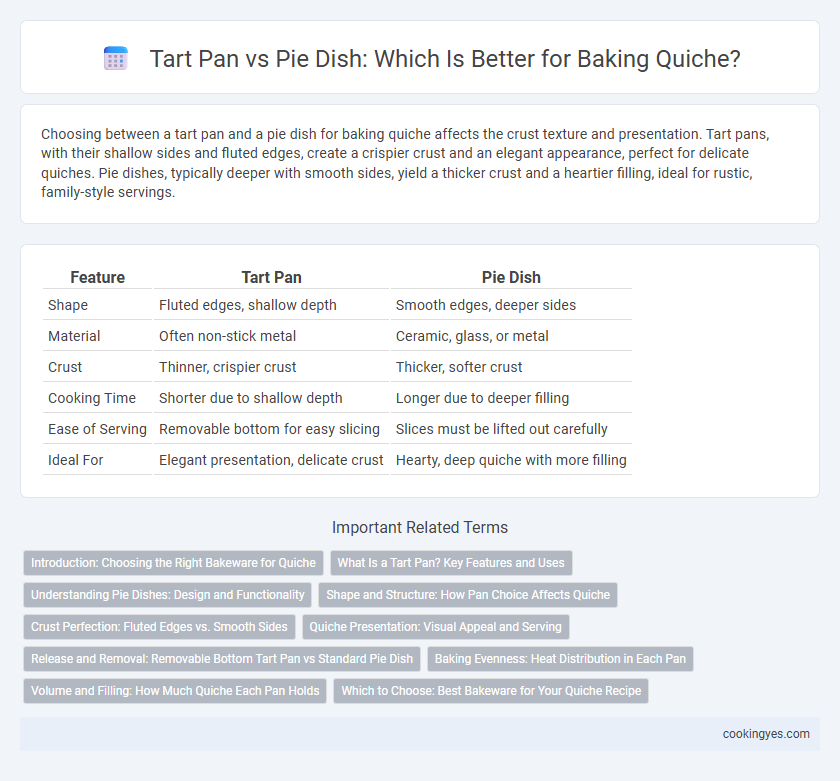Choosing between a tart pan and a pie dish for baking quiche affects the crust texture and presentation. Tart pans, with their shallow sides and fluted edges, create a crispier crust and an elegant appearance, perfect for delicate quiches. Pie dishes, typically deeper with smooth sides, yield a thicker crust and a heartier filling, ideal for rustic, family-style servings.
Table of Comparison
| Feature | Tart Pan | Pie Dish |
|---|---|---|
| Shape | Fluted edges, shallow depth | Smooth edges, deeper sides |
| Material | Often non-stick metal | Ceramic, glass, or metal |
| Crust | Thinner, crispier crust | Thicker, softer crust |
| Cooking Time | Shorter due to shallow depth | Longer due to deeper filling |
| Ease of Serving | Removable bottom for easy slicing | Slices must be lifted out carefully |
| Ideal For | Elegant presentation, delicate crust | Hearty, deep quiche with more filling |
Introduction: Choosing the Right Bakeware for Quiche
Selecting the right bakeware significantly impacts quiche texture and presentation, with tart pans offering straight, fluted sides that create a crispier crust, enhancing visual appeal and even baking. Pie dishes feature sloped sides yielding a softer, more tender crust, suitable for traditional quiche varieties requiring gentle heat distribution. Understanding the differences between tart pans and pie dishes allows bakers to tailor their quiche outcome to texture preference and recipe requirements.
What Is a Tart Pan? Key Features and Uses
A tart pan is a shallow, round baking pan with straight, fluted sides and a removable bottom, designed specifically for delicate crusts like those in quiches. Its removable base allows for easy release of the quiche without damaging the crust, ensuring a clean presentation. Unlike deeper pie dishes, tart pans provide uniform heat distribution to achieve a perfectly crisp and golden quiche crust.
Understanding Pie Dishes: Design and Functionality
Pie dishes typically feature sloped sides and a wide rim, promoting even heat distribution for a perfectly baked quiche crust. Their design allows easier filling transfer and a slightly thinner crust, resulting in a more delicate texture. The pie dish's depth supports a balanced ratio of custard to crust, enhancing the overall flavor and structural integrity of quiche.
Shape and Structure: How Pan Choice Affects Quiche
Tart pans typically have straight, fluted sides and a removable bottom, resulting in a quiche with higher, more defined edges and an easy release from the pan. Pie dishes feature sloped sides and a fixed base, which creates a thicker crust and a softer edge texture, influencing both the presentation and baking consistency. Choosing a tart pan enhances sharp crust lines and even browning, while a pie dish promotes a heartier, more rustic quiche structure.
Crust Perfection: Fluted Edges vs. Smooth Sides
A tart pan, with its fluted edges, creates a decorative, crispy crust that enhances quiche presentation and texture, while a pie dish's smooth sides yield a thicker, softer crust ideal for rustic quiches. The fluted edges in tart pans ensure even heat distribution and help the crust bake uniformly, preventing sogginess commonly found in pie dishes. For a quiche with perfectly crisp, visually appealing crust, a tart pan is preferred over the traditional pie dish.
Quiche Presentation: Visual Appeal and Serving
A tart pan's fluted edges and removable bottom create a clean, elegant presentation, enhancing the visual appeal of quiche by showcasing its golden, crisp crust. In contrast, a pie dish offers a more rustic, homey look but can make serving slices less precise due to the lack of defined edges. For visually striking quiche intended for formal dining or special occasions, a tart pan provides a polished, professional finish that highlights the dish's aesthetic qualities.
Release and Removal: Removable Bottom Tart Pan vs Standard Pie Dish
A removable bottom tart pan offers superior ease of release and removal for quiche, enabling the crust to stay intact and maintain its shape when transferring to a serving plate. In contrast, a standard pie dish often requires careful loosening with a knife, increasing the risk of crust breakage and uneven edges. The detachable base of tart pans minimizes crust damage, making them ideal for delicate and visually appealing quiches.
Baking Evenness: Heat Distribution in Each Pan
A tart pan, often made of metal with fluted edges and a removable bottom, provides superior heat distribution, promoting even baking and a crisp crust in quiche. Pie dishes, commonly ceramic or glass, heat more slowly and retain warmth longer, which can lead to uneven cooking and a soggier crust. For optimal quiche results, choosing a tart pan ensures consistent heat transfer and uniform baking throughout the custard and crust.
Volume and Filling: How Much Quiche Each Pan Holds
A tart pan typically holds 9 to 11 inches in diameter with shallow sides, accommodating about 1.5 to 2 cups of quiche filling, ideal for thinner, evenly cooked quiches. Pie dishes have deeper sides, usually 9 inches in diameter but with a capacity of roughly 3 to 4 cups, allowing for a thicker quiche with more filling and a robust crust edge. Choosing between a tart pan and pie dish depends on the desired quiche volume and texture, with the pie dish suited for heartier portions and the tart pan for delicate, crisp crusts.
Which to Choose: Best Bakeware for Your Quiche Recipe
Choosing between a tart pan and a pie dish for baking quiche depends on the desired crust texture and presentation. Tart pans with removable bottoms provide crispier edges and a professional look, ideal for delicate, flaky crusts. Pie dishes, typically deeper with sloped sides, offer a heartier crust and more filling capacity, perfect for rustic, family-style quiches.
Tart Pan vs Pie Dish for baking quiche Infographic

 cookingyes.com
cookingyes.com